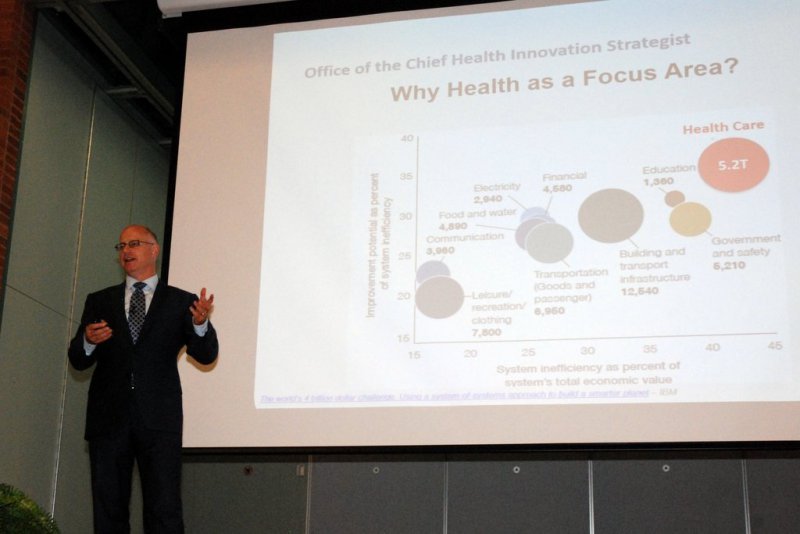 I’m a strong believer in technology’s ability to improve healthcare outcomes and make us healthier and safer. Because I know what technology can do for healthcare, I’m impatient about realizing its promises.
I’m a strong believer in technology’s ability to improve healthcare outcomes and make us healthier and safer. Because I know what technology can do for healthcare, I’m impatient about realizing its promises.
Last month I had the opportunity to meet with a group of people who share my optimism about healthcare technology and – more importantly – are taking critical steps to bring it to fruition faster. The group – which was brought together by the University of Waterloo’s Center for Bioengineering and Biotechnology and Grand River Hospital in Ontario – convened for the Waterloo Region MED TECH Bridging the Gap Conference. It was an incredible event that connected people from many industries and walks of life who spoke very eloquently about the significance of technology for improving healthcare outcomes.
I came away with renewed confidence that we’re at a watershed moment for the integration of healthcare and technology. We’re seeing a huge need for healthcare technology, and, at Bridging the Gap, I saw a tremendous amount of passion for bringing these innovations to market.
Here are my five biggest takeaways from a day full of “a-ha moments” about healthcare IT.
5. New healthcare regulations, the growing aging population, and the need to reduce healthcare expenditures are putting more pressure on the healthcare system, and efficiency-boosting technology innovations will enable healthcare organizations to handle the growing demands placed on them.
4. Improving patient care and outcomes must be our primary goal with new healthcare technology. It’s important to discriminate between technology that’s just new and technology that effectively improves what we already offer patients.
3. Collaboration is essential to achieve our goals of improving patient care. At Bridging the Gap, we heard from technologists, healthcare providers, local and national government agencies, researchers, entrepreneurs, and others. This diverse representation of experience, knowledge, and viewpoints is critical to finding solutions that will work and improve healthcare.
2. Related to #3, it’s essential that we all put our personal agendas by the wayside for the overall good. Mobility, BlackBerry’s wheelhouse, has a vital role in improving healthcare, but so do big data, analytics, digitalization, and many other technologies. I appreciate that this group is willing to share our expertise, without advocating to the point that we cannibalize the overall mission. Instead, we’re looking for common solutions and ways to integrate our technologies, and that’s the path we want to take forward.
 1. Finally, public-private partnerships are the key avenue we have to address points 1-4 and solve healthcare’s most pressing challenges. In the past, government and healthcare leaders’ reluctance to take risks has hindered technology innovation, reported Communitech News. But change is coming, thanks to the Canadian government’s backing for private innovators. William Charnetski (pictured here), Chief Health Innovation Strategist at the Ministry of Health and Long-Term Care and a keynote speaker at the Bridging the Gap conference, announced a $20 million fund to spur innovation in healthcare technology. This, along with a new incubator for Canadian startups working on medical technology in Ontario, signals a tremendous amount of energy around not only healthcare tech, but also around the public-private partnerships we need to achieve its promise.
1. Finally, public-private partnerships are the key avenue we have to address points 1-4 and solve healthcare’s most pressing challenges. In the past, government and healthcare leaders’ reluctance to take risks has hindered technology innovation, reported Communitech News. But change is coming, thanks to the Canadian government’s backing for private innovators. William Charnetski (pictured here), Chief Health Innovation Strategist at the Ministry of Health and Long-Term Care and a keynote speaker at the Bridging the Gap conference, announced a $20 million fund to spur innovation in healthcare technology. This, along with a new incubator for Canadian startups working on medical technology in Ontario, signals a tremendous amount of energy around not only healthcare tech, but also around the public-private partnerships we need to achieve its promise.
I’m thrilled that BlackBerry is playing a key role in this collaborative initiative to advance the medical technology field. I’ll be heading back to Waterloo soon to continue the important work we started at Bridging the Gap in May, and I look forward to making more progress toward establishing the devices and platforms that will improve outcomes for healthcare providers, funders, and, most importantly, patients.
Learn more about the life-changing impacts of secure mobile healthcare solutions across the continuum of care.
